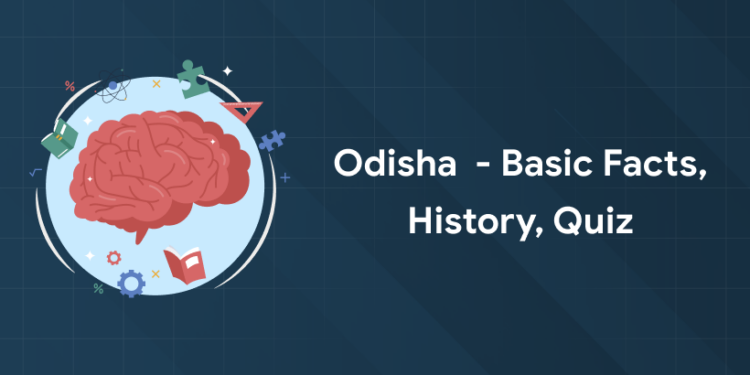Table of Contents
Odisha – Basic Facts, History, Quiz: The Indian state of Odisha, originally known as Orissa, is located on the east coast facing the Bay of Bengal. It is the eighth largest state in the country. Odisha has West Bengal and Jharkhand to the north, Chhattisgarh to the west and Andhra Pradesh and Telangana to the south. Bhubaneshwar, the capital city of Odisha, is the largest city in the state. Before independence Cuttack was the capital of Odisha.
Odisha was known by several names in the past. Kalinga, Utkala (mentioned in the Indian national anthem), Odra Desha etc. are some of them. It is also widely known as the land of Lord Jagannath. Find Odisha – Basic Facts, History, Quiz below.
History of Odisha
The early history of Odisha can be traced back to the mentions found in ancient texts like the Mahabharata some Puranas. Long since the rule of Asoka, Odisha was ruled by several dynasties. Have a look at the dynasties that ruled Odisha.
- Second century BC: Kharavela
- Fourth century AD: Samudragupta
- 610 AD: King Sasanka followed by Harsha
- Seventh century AD: Ganga Dynasty
- 795 AD: Mahasivagupta Yajati II
- Mid- 16th Century: Several Muslim kings
- 1592: Akbar
- 1751: Marathas
- 1803: British empire
The British divided the region into parts of other provinces. Odisha was made into a separate province on 1 April 1936. It was formed on the basis of populations of Odia speaking people. The foundation day of Odisha, also known as Utkala Dibasa, is celebrated every year on the first day of April. The term “Utkala” that appears in our National Anthem denotes this region.
Odisha and parts of it were referred by different names in different era – Kalinga, Utkala, Mahakantara, Udra, Orda, Oddiyana, Kamala Mandala, South Kosala, Kongoda, Trikalinga, Chedi, Tosali, Uranshin, Jajnagar, Odivissa etc.
Geographical Features of Odisha
Odisha lies between the latitudes 17.780N and 22.730N, and between longitudes 81.37E and 87.53E. It lies just South of the Tropic of Cancer and has an area of 155,707 km2, which is 4.87% of total area of India, and a coastline of 450 km. There are six major rivers in Orissa flowing into the Bay of Bengal- Subarnarekha, Budhabalanga, Baitarani, Brahmani, Mahanadi and Rushikulya. Three fourth of the state is covered with mountain ranges. There are deep and broad valleys that have fertile soil and are densely populated. It also has plateaus and rolling uplands.
There are three major seasons – summer (from March to June), monsoon (from July to September) and the winter ( from October to February). The state has tropical climate, characterized by high temperature, high humidity, medium to high rainfall and short and mild winters.
Attempt free mock tests with Entri App
Government of Odisha
The state of Odisha has a unicameral legislature. The Odisha Legislative Assembly consists of 147 elected members. The current Chief Minister is Naveen Patnaik and the Governor is Ganeshi Lal.
Culture of Odisha
Odisha culture is influenced by the Aryan, Dravidian and Adivasi cultures. Odisha has rich cultural heritage with its historical monuments, archaeological sites, traditional arts, sculpture, dance and music. There are several festivals celebrated across the state. Durga Puja, Kali Puja, Chaitra Parva, Chandan Yatra, Snana Yatra, Ratha Yatra, Makar, Holi etc.
Odisha is predominantly a land of tribes and every tribe has its distinct song and magnificence of dance. The Odisha culture has a lot of songs which are predominately from the tribal people. The Odia music forms a part of Indian classical music. The Odissi classical dance form is world famous besides fold dances such as Chhau, Chaiti Ghoda, etc.
Odisha is famous for its varied forms of artwork. The rock art paintings, sand artwork found on the beaches, the handworks on jewelry, painting on the clothes known as pattachitra are some of the artworks found in the state.
Rice is the staple food of the people of Odisha. Compared to the cuisines of other states, Odia cuisine uses less oil and spice. Some of the traditional dishes are Pakhala (water-soaked rice), Chhena Poda (a roasted cheese dessert) and Mansa Tarkari (meat curry cooked with potatoes).
The traditional clothes for women are saree and for men, it is dhoti-kurta. Men also use gamacha which is a cotton towel that is wrapped around the shoulder while working in the fields. Lungi is also a common dress in Odisha. Sambalpuri Pata Sari, Patta Chitra Sari, handloom fabric made shirts are some of the traditional dresses of Odisha.
Economy of Odisha
Agriculture is one of the main occupations for the people of Odisha. Being close to the oceans and with some good ports, fishery is also one of the earning sectors along with the aquaculture. There are some small scall industries and handloom industries as well.
Odisha has considerable mineral resources. The state is a national leader in the production of chromite, bauxite (aluminum ore), manganese ore, graphite, and nickel ore. It is also one of the top producers of high-quality iron ore.
People of Odisha
An ethnic group of eastern India, known as Odia, constitute the majority in the state of Odisha. Most of the Odias are Hindus and are known for their sun worship. Some of the other tribes in Odisha are Kondh, Santal, Munda, Oram, and Gond. Christians and Muslims form the minority community in Odisha. There are a total of 62 distinct tribes in Odisha.
Flora and Fauna of Odisha
Nearly one third of the state is covered by forests which is divided into two categories: tropical moist deciduous and tropical dry deciduous forests. Tropical moist deciduous forests are found towards the northeastern part whereas tropical dry deciduous forests are found towards southwest of the state. Teak, rosewood, bamboo and padauk are some of the trees found in the region.
Major part of the wildlife of Odisha is protected in parks and sanctuaries established by the state and national governments. Mammals like elephants, gaurs (wild cattle), blackbucks, four-horned antelope, several types of tigers, various species of monkeys and peacocks are widely found. Chilka Lake is a breeding ground for many fish and water fowl.
Interesting Facts About Odisha
- Odisha was the first state in India to be formed on linguistic basis.
- Odisha hosts the world’s largest open air theatre – Dhanu Yatra.
- The Konarka Sun temple, built in thirteenth century, has amazing architecture. The 24 wheels on the temple help calculate the precise time by looking at the shadow cast by it.
- Odissi is the oldest surviving dance form of India.
- Odisha is the first state to enact the Lokayuktha Bill law after the act was passed in the Parliament.
- Bhubaneswar, known as the Temple City of India, is the only city in the world with over 600 magnificent temples.
- The largest lion safari of India and the only white tiger safari in the world are located in Nandankanan Zoological Park of Bhubaneswar.
- Hirakud dam, the fourth largest dam in the world, is in Sambalpur, Odisha.
- The Leaning Temple of Huma, the only leaning temple in the world, is located in Odisha.
- Wheeler Island in Odisha is a place where most of the missiles of India are tested.
- World’s largest egg, that of a gigantic herbivorous flightless elephant bird, is preserved at Regional Museum of Natural History in Bhubaneswar.
- Odisha is the highest producer of hematite ore in India.
- World’s largest turtle nesting ground is in Odisha.
- The Land Revenue System was first started in Ganjam, a district in Odisha, even before it was implemented in India.
- The famous sweet Rasagulla originated in Odisha.
Symbols of Odisha
State Flower: Ashoka
State Tree: Sacred fig
State Animal: Sambar
State Bird: Indian Roller
State Dance: Odissi
State Music: Bande Utkala Janani
State Language: Odia
Highest point in the state: Deomali in Koraput district
Number of districts: 30
Number of National Parks in the state: Five
Father of Odisha: Fakir Mohan Senapati
Odisha Day Quiz 2024
Which is the highest peak in Odisha?
Deomali in Koraput district
How many members are there in the Odisha Legislative Assembly?
147
How many districts are there in Odisha?
30
How many dams are there in Odisha?
163
Which is the biggest river of Odisha?
The Mahanadi
Which is the largest waterfall in Odisha?
Barehipani Falls
Who was the first Chief Minister of Odisha?
Harekrushna Mahatab
In which year was the war of Kalinga fought?
261 BC
When was the Konark Temple include in the World Heritage Site status?
1984
What was the capital of Odisha before Bhubaneswar?
Cuttack
Which ruler started the construction of Konark Temple?
Narasimhadeva I
Which is the largest district of Odisha?
Mayurbhanj
On which river is the Hirakud dam built?
Mahanadi
Which dynasty of Odisha witnessed the successful reign of queens?
Bhauma Kara
Which place is known as “Bhata Handi” of Odisha state?
Bargarh
Which districts of Odisha are declared as drought-prone?
Bolangir, Bargarh, Nuapada, Kalahandi
On which river valley is the Talcher coalfield of Odisha situated?
Brahmani
Where is the Biju Patnaik Energy park situated?
Bhubaneswar
Which city has been considered by the Government of Odisha for implementing the Solar City Program?
Bhubaneswar
In which year did Odisha became a separate province?
1936
Barabati Cricket Stadium of Odisha is an alternate venue for home matches of which of the following IPL team of India?
Kolkata Knight Riders
Which district is known as the Industrial capital of Odisha?
Angul













